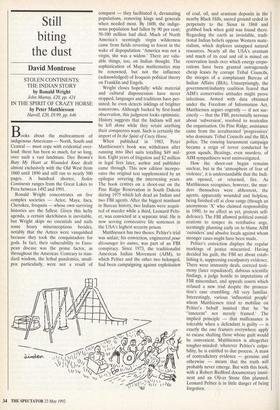Still biting the dust
David Montrose
Books about the maltreatment of indigenous Americans — North, South and Central — must cope with evidential over- load: there has been so much, for so long, over such a vast landmass. Dee Brown's Bury My Heart at Wounded Knee dealt almost exclusively with the Old West from 1860 until 1890 and still ran to nearly 500 pages. A hundred shorter, Stolen Continents ranges from the Great Lakes to Peru between 1492 and 1991.
Ronald Wright concentrates on five complex societies — Aztec, Maya, Inca, Cherokee, Iroquois — whose own surviving histories are the fullest. Given this hefty agenda, a certain sketchiness is inevitable, but Wright skips no essentials and nails some hoary misconceptions besides, notably that the Aztecs were vanquished because they took the conquistadors for gods. In fact, their vulnerability to Euro- pean disease was the prime factor, as throughout the Americas. Contrary to stan- dard wisdom, the lethal pandemics, small- pox particularly, were not a result of conquest — they facilitated it, devastating populations, removing kings and generals when needed most. By 1600, the indige- nous population had fallen by 90 per cent; 50-100 million had died. Much of North America's seemingly virgin wilderness came from fields reverting to forest in the wake of depopulation: 'America was not a virgin, she was a widow.' There are valu- able things, too, on Indian thought. The sophistication of Maya mathematics may be renowned, but not the influence (acknowledged) of Iroquois political theory on Franklin and Engels.
Wright closes hopefully: while material and cultural dispossession have never stopped, languages and traditions have per- sisted; he even detects inklings of brighter tomorrows. Although backed by first-hand observation, this judgment looks optimistic. History suggests that the Indians will not be left alone while they retain anything their conquerors want. Such is certainly the import of In the Spirit of Crazy Horse.
When published in 1983, Peter Matthiessen's book was withdrawn after running into libel suits totalling $49 mil- lion. Eight years of litigation and $2 million in legal fees later, author and publisher came through. This new edition incorpo- rates the original text supplemented by an epilogue covering the intervening years. The book centres on a shoot-out on the Pine Ridge Reservation in South Dakota during 1975 which left dead an Indian and two FBI agents. After the biggest manhunt in Bureau history, two Indians were acquit- ted of murder while a third, Leonard Pelti- er, was convicted at a separate trial. He is now serving consecutive life sentences in the USA's highest security prison.
Matthiessen has two theses: Peltier's trial was unfair; his conviction, engineered pour decourager les autres, was part of an FBI conspiracy. Since 1973, the traditionalist American Indian Movement (AIM), to which Peltier and the other two belonged, had been campaigning against exploitation of coal, oil, and uranium deposits in the nearby Black Hills, sacred ground ceded in perpetuity to the Sioux in 1868 and grabbed back when gold was found there. Regarding the earth as inviolable, tradi- tional Indian beliefs oppose Western mate- rialism, which deplores untapped natural resources. Nearly all the USA's uranium and much of its coal and oil is mined on reservation lands over which energy corpo- rations have been granted outrageously cheap leases by corrupt Tribal Councils, the stooges of a complaisant Bureau of Indian Affairs (BIA). Unsurprisingly, the government/industry coalition feared that AIM's conservative attitudes might prove infectious. Armed with data obtained under the Freedom of Information Act, Matthiessen argues cogently — if not suc- cinctly — that the FBI, perennially nervous about 'subversion', resolved to neutralise the organisation. On Pine Ridge, assistance came from the acculturated 'progressives' who dominate Tribal Councils and the BIA police. The ensuing harassment campaign became a reign of terror conducted by goon squads. Beatings, even murders, of AIM sympathisers went uninvestigated.
How the shoot-out began remains unclear, but in the 'atmosphere of fear of violence', it is understandable that the Indi- ans opened, or returned, fire. As Matthiessen recognises, however, the mur- ders themselves were abhorrent, the agents, apparently wounded and helpless, being finished off at close range (though an anonymous 'X' who claimed responsibility in 1990, to no effect as yet, protests self- defence). The FBI allowed political consid- erations to temper its retributive urge, seemingly planning early on to blame AIM `outsiders' and absolve locals against whom stronger cases might have been made.
Peltier's conviction displays the regular markings of justice miscarried. Having decided his guilt, the FBI set about estab- lishing it, suppressing exculpatory evidence. There were immunity deals, coerced testi- mony (later repudiated), dubious scientific findings, a judge hostile to imputations of FBI misconduct, and appeals courts which refused a new trial despite the prosecu- tion's case crumbling. All very familiar. Interestingly, various `influential people' whom Matthiessen tried to mobilise on
Peltier's behalf insisted that he 'be "innocent" not merely framed.' The implied principle — that malfeasance is tolerable when a defendant is guilty — is exactly the one framers everywhere apply to excuse shafting those whose guilt would be convenient. Matthiessen is altogether tougher-minded: whatever Peltier's culpa- bility, he is entitled to due process. A mass
of contradictory evidence — genuine and otherwise — means that the truth will probably never emerge. But with this book,
with a Robert Redford documentary immi- nent and an Oliver Stone film planned, Leonard Peltier is in little danger of being forgotten.


































































 Previous page
Previous page